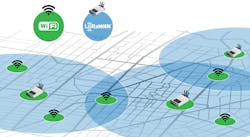To Succeed in IoT, Consider Using Multiple Radios
Among 2020’s bright spots (yes, there have been a few) is that it’s represented a turning point for IoT adoption. An important factor in the broadening adoption has been reliance on unlicensed wireless technologies like Wi-Fi and LoRaWAN. If deploying one of those technologies is a winning strategy in an IoT application, what about combining them in a multi-radio strategy?
A collaboration between members of the Wireless Broadband Alliance (WBA) and the LoRa Alliance demonstrated that hybrid Wi-Fi and LoRaWAN connectivity increases market opportunities, delivers a strong return on investment (ROI), and offers enhanced network implementations. Adding LoRaWAN to Wi-Fi using network mutualization is a cost-effective approach to deployment using the existing base of Wi-Fi access points. Thus, it presents a significant opportunity for Wi-Fi providers to expand their addressable businesses on complementary use cases that cover both broadband applications and massive IoT leveraging the license-exempt spectrum.
In a new whitepaper, “Wi-Fi & LoRaWAN Trials—An Overview of Use Cases Across Regions Combining Two Technologies,” the two alliances provide details on practical trials and proof-of-concept deployments (POCs) representing a variety of uses cases implemented across different geographies and verticals. It builds on an earlier whitepaper, “Wi-Fi & LoRaWAN Deployment Synergies: Expanding Addressable Use Cases for the Internet of Things,” comparing the two technologies theoretically and showing how they could effectively support a vast array of use cases.
As two of the most widely adopted unlicensed wireless technologies, Wi-Fi and LoRaWAN address a large proportion of current IoT use cases. Both are disrupting private-public business models and enable participation in the 5G ecosystem and development of capabilities for IoT roaming, using OpenRoaming models. Eleven companies representing both alliances from all global regions contributed to this work, including: Actility, Abeeway, Boingo Wireless, Charter Communications, Cisco, Kerlink, Lacuna Space, Nesten, Simplycity, Skyhook, and Semtech.
- Covered use cases include:
- Smart Buildings: Multi-Family Dwellings (Boingo Wireless, United States)
- Smart City: Smart Light Pole (Charter Communications, United States)
- Smart City: Energy Management and People Attendance Monitoring (Simplycity, Australia)
- Smart City: Interoperability between Wi-Fi and LoRaWAN at the Network Level (Nesten, Skyhook, United States)
- Smart Interconnection: OpenRoaming & LoRaWAN (ORL) (Cisco, Switzerland)
- Smart Retail: Wi-Fi & LoRaWAN In-Store Retail Analytics (Kerlink, Smart Traffik, The Netherlands)
- Smart Tracking: Tracking with Semtech LoRa Edge and Lacuna Satellites to Resolve Human-Wildlife Conflict (Lacuna Space, IRNAS and Smart Parks, South Africa)
- Smart Transportation: Asset Tracking for the Automotive Industry (Actility, Abeeway, Volvo, France)
The goal is that details on the above use cases will spark inspiration among existing market players that have deployed both Wi-Fi and LoRaWAN, helping them leverage their networks to support innovative new applications. Moreover, network operators, enterprises, or communities that have deployed either Wi-Fi or LoRaWAN networks can learn ways to extend their offerings by adding the other complementary technology.
In what will hopefully be a model for the wireless industry, WBA and the LoRaWAN Alliance are showing the way toward supporting the rapidly accelerating wireless infrastructure. Homes, cities, transport systems, and retailers all stand to benefit by augmented capacity and coverage and increased ROI.
About the Author
David Maliniak
Executive Editor, Microwaves & RF
I am Executive Editor of Microwaves & RF, an all-digital publication that broadly covers all aspects of wireless communications. More particularly, we're keeping a close eye on technologies in the consumer-oriented 5G, 6G, IoT, M2M, and V2X markets, in which much of the wireless market's growth will occur in this decade and beyond. I work with a great team of editors to provide engineers, developers, and technical managers with interesting and useful articles and videos on a regular basis. Check out our free newsletters to see the latest content.
You can send press releases for new products for possible coverage on the website. I am also interested in receiving contributed articles for publishing on our website. Use our contributor's packet, in which you'll find an article template and lots more useful information on how to properly prepare content for us, and send to me along with a signed release form.
About me:
In his long career in the B2B electronics-industry media, David Maliniak has held editorial roles as both generalist and specialist. As Components Editor and, later, as Editor in Chief of EE Product News, David gained breadth of experience in covering the industry at large. In serving as EDA/Test and Measurement Technology Editor at Electronic Design, he developed deep insight into those complex areas of technology. Most recently, David worked in technical marketing communications at Teledyne LeCroy, leaving to rejoin the EOEM B2B publishing world in January 2020. David earned a B.A. in journalism at New York University.

